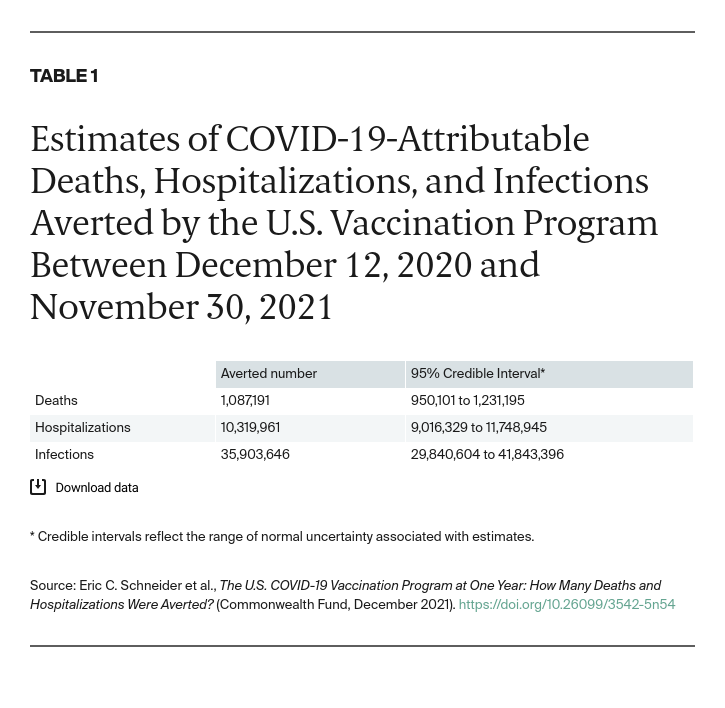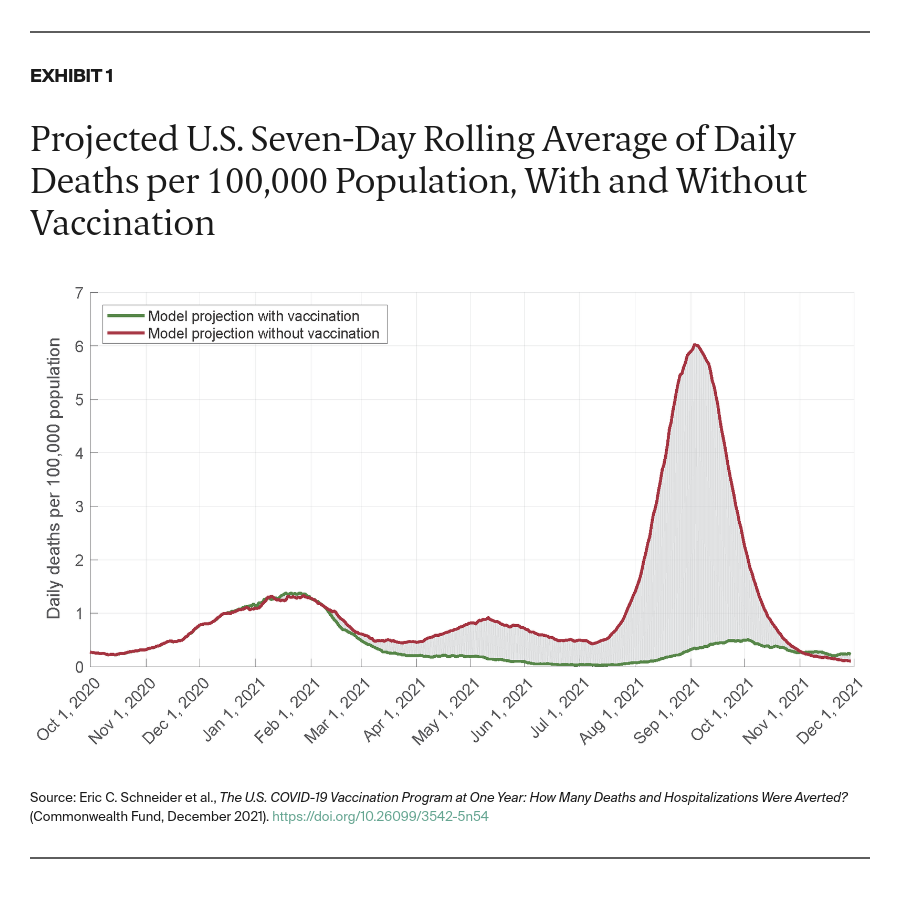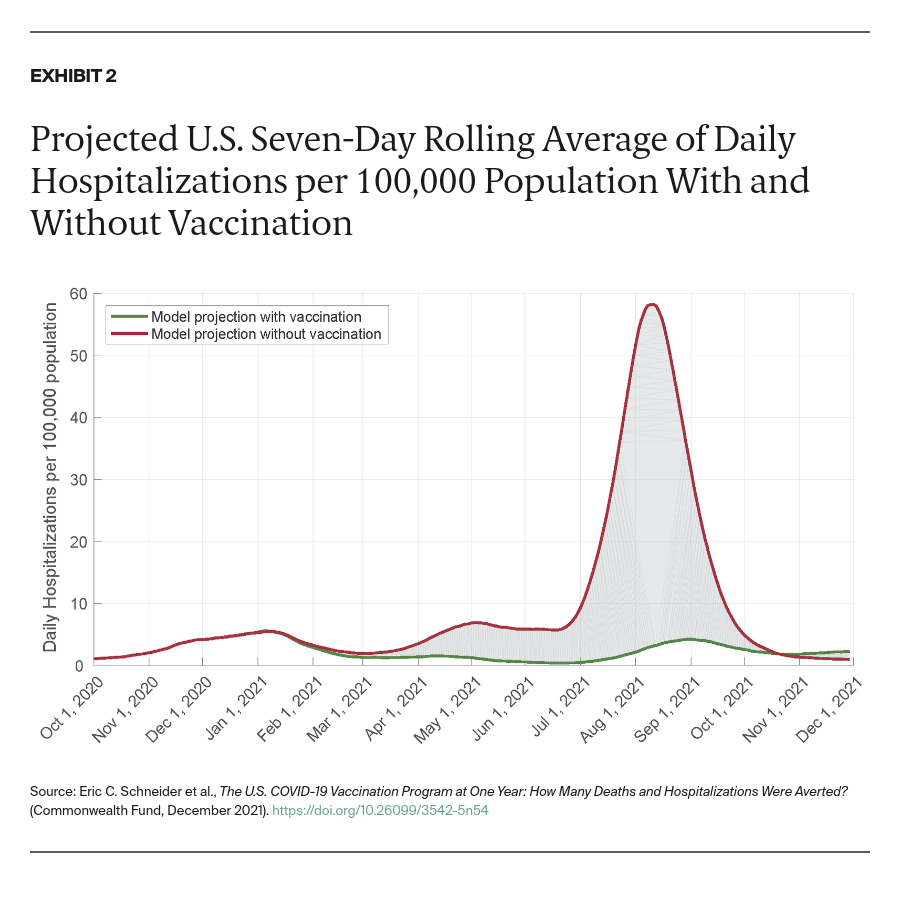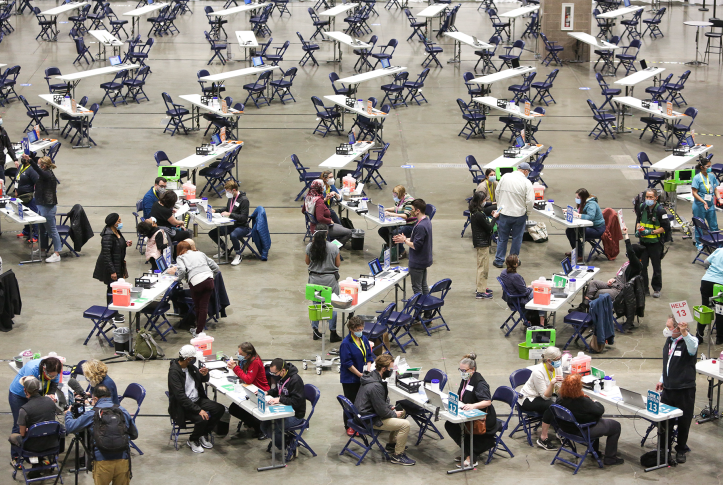Highlights
- In the absence of a vaccination program, there would have been approximately 1.1 million additional COVID-19 deaths and more than 10.3 million additional COVID-19 hospitalizations in the U.S. by November 2021.
- Without the U.S. vaccination program, COVID-19 deaths would have been approximately 3.2 times higher and COVID-19 hospitalizations approximately 4.9 times higher than the actual toll during 2021.
- If no one had been vaccinated, daily deaths from COVID-19 could have jumped to as high as 21,000 per day — nearly 5.2 times the level of the record peak of more than 4,000 deaths per day recorded in January 2021.
Background
Nearly 800,000 Americans have died so far during the U.S. COVID-19 pandemic, with more than half those deaths occurring during 2021.1 One year into the U.S. vaccination effort, much attention has focused on the stubborn persistence of the pandemic, which has been fueled by new, more- transmissible variants and the millions of Americans who have not gotten their shots. However, the positive impact of the rapid development and deployment of highly effective vaccines — the reduction in deaths and hospitalizations — has been less obvious.
In July, we reported that the U.S. vaccination program had averted 279,000 deaths and 1.25 million hospitalizations, primarily by blunting a surge in the Alpha variant during spring 2021.2 Since that report, nearly all of the U.S. has experienced a wave of infections, hospitalizations, and deaths caused by the highly transmissible Delta variant. More than 1,000 Americans are dying each day.
In this report, we update our estimates, through the end of November 2021, of COVID-related deaths and hospitalizations avoided because of the U.S. vaccination program. Briefly, the agent-based computer model analyzes features of the coronavirus, its transmission, and its effects to compare the observed pandemic trajectory (infections, hospitalizations, and deaths) to a counterfactual scenario in which no vaccination program exists. The model incorporates the transmission dynamics of previous variants other than Omicron, which is only now beginning to appear in the U.S. The model accounts for waning immunity and changes in population behavior over time as schools and businesses have reopened and travel has increased. We have refined the model to reflect emerging scientific evidence. See “How We Conducted This Study” at the end of this brief for further details on our methods.
Findings
Through November 2021, we estimate that the COVID-19 vaccination program in the United States prevented 1,087,191 additional deaths and 10,319,961 additional hospitalizations (Table 1). There would have been an estimated 35,903,646 additional infections.

The majority of these averted deaths and hospitalizations would have occurred during the late summer and early autumn, as the highly contagious Delta variant began to surge in southern states and spread to other parts of the U.S. As Exhibit 1 illustrates, the daily peak would have exceeded 21,000 deaths per day (6.3 per 100,000 population), far eclipsing the actual peak of 4,000 per day (1.6 per 100,000 population) reached during January 2021.

Exhibit 2 shows a similar pattern for hospitalizations. A peak of more than 55 hospitalizations per 100,000 population far exceeds the rate of hospitalization attributable to influenza during a severe flu season (typically fewer than 10 per 100,000).

Discussion
The U.S. vaccination program campaign has profoundly altered the trajectory of the COVID-19 pandemic, preventing nearly 1.1 million deaths. Even with only about 60 percent of Americans vaccinated to date, the nation has dodged a massive wave of COVID-19 deaths that would have started as the Delta variant took hold in August 2021. Because of Delta’s rapid and nationwide spread, deaths due to COVID-19 would have far exceeded all previous peaks.
Our estimates suggest that in 2021 alone, the vaccination program prevented a potentially catastrophic flood of patients requiring hospitalization. It is difficult to imagine how hospitals would have coped had they been faced with 10 million people sick enough to require admission. The U.S. has 919,000 licensed hospital beds and typically accommodates about 36 million hospitalizations each year.3 Even the 2.6 million COVID-related hospitalizations that occurred during 2021 placed an enormous strain on hospitals, with many staff lost not only to the virus but also to exhaustion and burnout. Faced with such unprecedented demand, U.S. hospitals operating under crisis standards of care would likely have had no choice but to turn away tens of thousands or even hundreds of thousands of individuals.
In addition to reducing hospitalization and death, vaccination prevented many millions of COVID infections, reducing the prospect that millions of Americans could develop long COVID and its debilitating symptoms.
These estimates of vaccination impact may seem startlingly high. But they are consistent with the extraordinary effectiveness of vaccines. Data from the Centers for Disease Control and Prevention show how dramatically COVID-19 vaccination reduces the risk of hospitalization and death. By the end of October 2021, rates of hospitalization among unvaccinated adults (47.3 per 100,000) were nearly 12 times the rate of fully vaccinated adults (3.9 per 100,000).4
How Would Differing Assumptions Affect These Results?
Changing selected assumptions in our analysis could reduce or increase the estimates we report here. For example, our model assumes that the reopening of businesses and schools, along with the increase in social gatherings that occurred during summer 2021, continued despite the Delta wave. If people had restricted social activities and travel, or businesses or schools had closed in response to the Delta surge, many deaths and hospitalizations could have been averted even in the absence of vaccination. However, it seems unlikely that the entire nation would have returned to the restrictions imposed during the first year of the pandemic.
Conversely, the number of deaths estimated by the model may be too low if hospital capacity were exceeded (as it surely would have been). Moreover, the model estimates only death attributable to COVID-19. Preventable deaths due to other causes would have increased too, as occurred early in the pandemic in cities like New York City and Los Angeles.5
The Continuing Urgency of Vaccination Efforts
Our findings highlight the ongoing tragedy of preventable death and hospitalization occurring among unvaccinated Americans. Daily vaccination rates have ticked up recently but only recently to 60 percent of the U.S. population — a lower rate than that achieved by dozens of other countries. As immunity wanes and breakthrough infections continue to emerge, it is clear we must vaccinate (and give booster shots) to many more people — building on the tremendous, though mostly invisible, successes the U.S. vaccination program has accomplished thus far.
As the Omicron variant begins to spread and the Delta variant surge continues, our results point to the tremendous power of vaccination to reduce disease and death from COVID-19. Sadly, they also highlight the ongoing tragic consequences of failing to vaccinate every eligible American.
